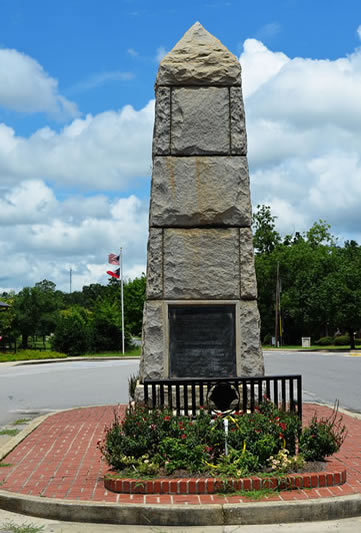Colonel Benjamin Hawkins Gravesite Listed in the National Register of Historic Places
 ATLANTA (November 21, 2011) - The Colonel Benjamin Hawkins Gravesite, located in a rural area southwest of Roberta in Crawford County, approximately five miles from Knoxville, was listed in the National Register of Historic Places at the state level of significance on November 10, 2011. The Crawford County Historical Society and Crawford County Board of Commissioners sponsored the nomination and a volunteer prepared the nomination materials. ATLANTA (November 21, 2011) - The Colonel Benjamin Hawkins Gravesite, located in a rural area southwest of Roberta in Crawford County, approximately five miles from Knoxville, was listed in the National Register of Historic Places at the state level of significance on November 10, 2011. The Crawford County Historical Society and Crawford County Board of Commissioners sponsored the nomination and a volunteer prepared the nomination materials.
Benjamin Hawkins was President George Washington's official Indian Agent for
the Southeast from 1796 to 1816. Hawkins was born August 15, 1754 in present-day
Warren County, North Carolina. The outbreak of the American Revolution ended
Hawkins' studies at the College of New Jersey (later Princeton University).
George Washington recruited Hawkins to join the general's staff as a French
translator. After the war, Hawkins held several state political offices in
North Carolina, represented Congress during negotiations between the federal
government and the Creek and Cherokee tribes, and served in the U.S. Senate
(1789-1795). In 1796 in recognition of Hawkins' diplomatic skill, President
George Washington appointed him to serve as the "Principal Temporary Agent
for Indian Affairs South of the Ohio River."

In 1803 Hawkins settled in present-day Crawford County on 8,004 acres of land,
known as the Creek Agency Reserve, on both sides of the Flint River. The exact
location of Hawkins' homestead within the reserve is unknown. As part of a
plan to "civilize" and assimilate Southeastern tribes, Moravian missionaries
and skilled white craftsmen arrived at the agency in 1807 to teach weaving,
spinning and farming to local Creeks. The agency also served as the focal point
for contact between whites and the Creeks, who routinely visited the agency
to seek Hawkins' assistance. Hawkins held the position of Indian agent from
1796 until his death in 1816.
Colonel Benjamin Hawkins' Gravesite is the only known extant historic resource
in Georgia associated with Hawkins' influential diplomatic career. As a federally
appointed Indian Agent, Hawkins played an influential role in shaping the relationship
between the United States government and the Creek Indians during the late
18th and early 19th centuries. Washington chose Hawkins for his reputation
as a fair and just negotiator with the Cherokee and Creek Indians. Hawkins
served during a period of cultural and economic hardship among the Creeks and
other Southeastern Indians caused by a sharp decline in the deerskin trade.
Hawkins was instrumental in the development and implementation of the federal
government's "plan for civilization" for Native Americans. Despite Hawkins'
diplomacy and a plan that promoted Native American assimilation, the Creeks
and Cherokees were later aggressively removed from the state due to white settlement
pressure.

The grave is located on a small knoll on the eastern bluff above the Flint
River and is accessed from Benjamin Hawkins Road off Georgia Highway 128. Colonel
Hawkins was buried at the site in 1816 and the fieldstone monument marking
his grave was built in 1931. In the same year, a granite monument to Hawkins
was erected in downtown Roberta. Both commemorations were part of a larger
renewed interest in important people and places associated with the history
of Colonial America and the American Revolution. There is a bronze plaque on
one side of the monument that reads "Col. Benjamin Hawkins; 1754-1816; erected by John Houston and the Jeffersonia Hawkins Chapters D.A.R." The
Sons of the American Revolution recently placed a marble gravemarker on top
of the base, and a nonhistoric wood display board near the site provides visitors
with biographical information about Colonel Hawkins.
The National Register of Historic Places is our country's official list of historic buildings, structures, sites, objects, and districts worthy of preservation. The National Register provides formal recognition of a property's architectural, historical or archaeological significance. It also identifies historic properties for planning purposes and insures that these properties will be considered in the planning of state or federally assisted projects. National Register listing encourages preservation of historic properties through public awareness, federal and state tax incentives, and grants. Listing in the National Register does not place obligations or restrictions on the use, treatment, transfer, or disposition of private property.
The Historic Preservation Division (HPD) of the Georgia Department of Natural Resources serves as Georgia's state historic preservation office. Its mission is to promote the preservation and use of historic places for a better Georgia. HPD's programs include archaeology protection and education, environmental review, grants, historic resource surveys, tax incentives, the National Register of Historic Places, community planning and technical assistance.
The mission of the Department of Natural Resources is to sustain, enhance, protect and conserve Georgia's natural, historic and cultural resources for present and future generations, while recognizing the importance of promoting the development of commerce and industry that utilize sound environmental practices.
Colonel Hawkins,
|

